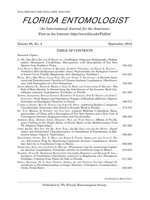The African oil palm (Elaeis guineensis Jacq.; Arecales: Arecaceae) is one of the most important oil producing plants yielding 4 to 6 tonnes of oil/ha/ yr in Brazil and 8 to 10 tonnes of oil/ha/yr in Asia (Camillo et al. 2009). Plantations of this crop in Para State, Brazil can reach up to 6 tonnes of oil/ ha/yr with appropriate technologies; and Brazil can be a leading world producer of renewable fuels especially in scenarios of rising petroleum oil prices and concern over environmental pollution (Abdalla et al. 2008; Brokamp et al. 2011). This palm is well adapted to the ecological conditions of the Amazonian region, which has the largest area available to expand this crop in the world (Chia et al. 2009).
Lepidopteran pests can damage African oil palm plants in South America; control of such pests with chemical pesticides, can cause environmental and socioeconomic problems (Zeddam et al. 2003). The northern region of Brazil presents great diversity of lepidopteran defoliators of oil palm including Opsiphanes invirae Hübner and Brassolis sophorae L. (Nymphalidae); Sibine spp. and Talima sp. (Limacodidae); Euprosterna sp., Automeris spp. (Saturniidae) and Saliana sp. (Hesperiidae); and these pests have high damage capacities (Ribeiro et al. 2010).
The aim of this study was to evaluate the occurrence of parasitoids and hyperparasitoids obtained from pupae of lepidopteran defoliators of the oil palm cultivated in Pará State, Brazil.
This work was conducted in oil palm plantations of the Agropalma Complex in the Municipality of Thailand, Southeast of Para State, Brazil. The total area of this company is 112,551 hectares with 39,700 hectares planted with oil palm. The geographical coordinates of the land of this company are S 24° 2′04″ W 48° 08′02″. The main cultivars of the oil palm grown in Brazil include ‘Avros’, ‘Lamé’,‘Ghana’, ‘Ekona’, ‘Embrapa-Lamé’ and ‘Kigoma’. Pupae of lepidopteran defoliators were first collected from Aug to Oct 2007 (dry season) and subsequently in Jan and Feb 2008 (rainy season).
One hundred Saliana sp. pupae and 2,261 O. invirae pupae were collected in the field and held individually in the laboratory at 27 ±1 °C, 75 ± 10% RH and 12:12 h L:D until emergence of adults of the parasitoids or the Lepidoptera. Adult parasitoids were mounted and/or maintained in 70% ethanol, sent for identification and deposited in the entomology collection of the EMBRAPA Eastern Amazon, Belém, Pará State, Brazil.
An average of 3 specimens of Brachymeria pandora was obtained from the each of the parasitized immatures of Saliana sp. and 1 individual each of the endoparasitoids Brachymeria annulipes and Brachymeria koehleri was obtained from each correspondingly parasitized O. invirae immature and from each parasitized pupa of the parasitoid Chetogena scutellaris (Wulp) (Diptera: Tachinidae). The genus Brachymeria Westwood (Chalcididae) has 45 species described in the Neotropical region (De Santis 1989; Tavares et al. 2006). Brachymeria koehleri Blanchard, 1935 has been registered in Venezuela, Brazil (Espírito Santo and Rio de Janeiro States) and Argentina; Brachymeria pandora (Crawford 1914) has been reported in Espírito Santo, Goiás and Rio de Janeiro States, Brazil and in Venezuela and Guyana; and Brachymeria annulipes (Costa Lima 1919) has been registered in Maranhão and Espírito Santo States, Brazil (Marchiori et al. 2003; Tavares & Araujo 2007).
Brachymeria koehleri was recorded as a hyperparasitoid from pupae of the parasitoid Chetogena scutellaris (Diptera: Tachinidae) that had been reared in pupae of O. invirae collected on oil palm plants. This species has also been reported as a hyperparasitoid of Tachinidae and Sarcophagidae (Diptera) from lepidopteran pupae, but it emerged from Alabama argillacea (Hübner) and Mocis latipes (Guenée) (Noctuidae) pupae (Terán 1980). Brachymeria annulipes parasitized Pectinophora gossypiella (Saunders) (Gelechidae) (Noyes 2002), and the parasitoid B. pandora emerged from pupa of Calpodesethlius (Stoll), Argon lota Hewitson (Hesperiidae) and Historis odius (Fabricius) (Nymphalidae) (Marchiori et al.2003; Gil-Santana & Tavares 2005; Salgado-Neto et al. 2010).
This is the first report of a species of the genus Brachymeria parasitizing pupae of O. invirae and Saliana sp., and as an hyperparasitoid of C. scutellaris in palm plantations in the Brazilian Amazonian region.
SUMMARY
The cultivation of the African oil palm is one the main agricultural activity in humid areas of the world, such as Amazonia, but defoliating caterpillars can reduce the productivity of this crop in northern Brazil. This is the first report in Brazil of occurrence of the parasitoids Brachymeria annulipes (Costa Lima 1919) from pupae of Opsiphanes invirae (Hübner 1808) (Nymphalidae), Brachymeria pandora (Crawford 1919) (Chalcididae) from those of Saliana sp. (Hesperiidae) and Brachymeria koehleri Blanchard, 1935 as an hyperparasitoid of pupae of the natural enemy Chetogena scutellaris (Tachinidae) from O. invirae on oil palm cultivated in Pará State, Brazil. This is the first report of species of the genus Brachymeria parasitizing pupae of O. invirae, and Saliana sp., and as an hyperparasitoid of C. scutellaris in palm plantations in the Brazilian Amazonian region.
Key Words: Elaeis guineensis, natural enemies, new records.
RESUMO
O cultivo da palma de óleo éa principal atividade agrícola em áreas úmidas do mundo, como a Amazônia, mas lagartas desfolhadoras podem reduzir a produtividade desta cultura no Norte do Brasil. Este é o primeiro relato no Brasil da ocorrência dos parasitoides Brachymeria annulipes (Costa Lima 1919) de pupas de Opsiphanes invirae (Hübner 1808) (Lepidoptera: Nymphalidae) e Brachymeria pandora (Crawford 1919) (Hymenoptera: Chalcididae) de pupas de Saliana sp. (Lepidoptera: Hesperiidae) e de Brachymeria koehleri Blanchard, 1935 como hiperparasitoide de pupas do inimigo natural Chetogena scutellaris (Wulp) (Diptera: Tachinidae) de O. invirae em cultivos da palma do óleo no Estado do Pará, Brasil. Este é, também, o primeiro relato de espécies do gênero Brachymeria parasitando pupas de O. invirae, Saliana sp. e de C. Scutellaris como hiperparasitoide em plantações de palmeiras na região Amazônica Brasileira.
Palavras-chave: Elaeis guineensis, inimigos naturais, novos registros.
ACKOWLEGMENTS
To “Conselho Nacional de Desenvolvimento Científico e Tecnológico (CNPq)”, “Coordenação de Aperfeiçoamento de Pessoal de Nível Superior (CAPES)” and “Fundação de Amparo à Pesquisa do Estado de Minas Gerais (FAPEMIG)” for financial support.





